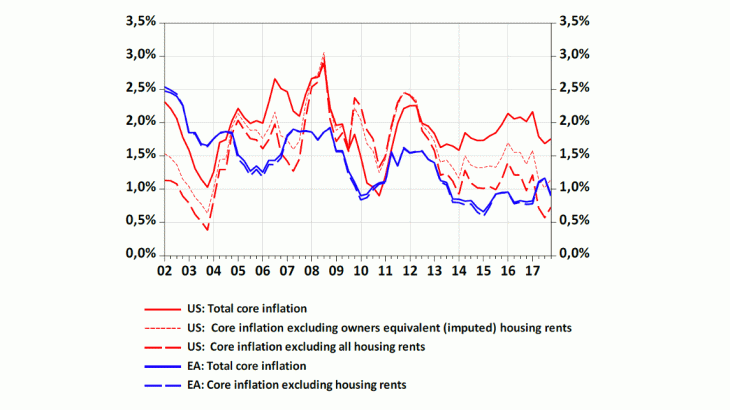A blogpost published here a year ago with Vincent Grossmann-Wirth (in French; in English) looked at the differences between core inflation in the United States and the euro area. Our main objective was to break down price indices in order to study comparable activities reflecting domestic macroeconomic conditions across the Atlantic. Hence, our analysis focused on what is referred to as "core" inflation, i.e. price inflation excluding energy and food. Energy and food prices are more volatile and, in the case of energy in particular, mainly determined by international factors. It is therefore better to exclude them when comparing the fundamental differences in inflation across countries. In this update, we focus on the United States and the euro area (rather than on France) because, as seen in last year’s blogpost, the story is similar for French and euro area inflation rates.
Our previous blogpost highlighted two striking facts:
- Fact 1. The pattern of US core inflation is very different when we exclude housing rents from the price index. By contrast, in the euro area, core inflation and core inflation excluding housing rents are similar.
- Fact 2. Since 2014, US core inflation has been about 1 pp higher than euro area core inflation. However, when we exclude housing rents, this difference almost vanishes in 2013 -2015 and is reduced by 2/3 in 2016. When excluding healthcare costs, this difference is reduced further, especially in 2016.
Based on these facts, we reached the conclusion that a good understanding of housing markets is key to interpreting differences between US and euro area inflation rates. One should not attribute to general macroeconomic conditions differences that are mostly driven by a specific sector whose activity and asset prices are known to follow peculiar cycles. There is no case for using or targeting a price index excluding housing – since it arguably represents a large share of households’ budget – but the singular features of housing price cycles should be taken into consideration when discussing inflation differentials.
Core inflation excluding housing rents is currently lower in the United States
Below, we present updates of these two stylised facts, with data from 2017:
- Fact 1 is a persistent feature (Chart 1). There have been frequent large differences between US core inflation and US core inflation excluding rents since 2000. The difference has been especially large and persistent since 2013, the date of recovery of the US housing market. Conversely, we still observe negligible differences between core inflation and core inflation excluding rents in the euro area. The difference between the United States and the euro area is only partly explained by the fact that imputed rents are included in the US index (see dotted thin red line in Chart 1). As explained in last year’s blogpost, such a difference arises because US rents vary differently from core inflation (higher growth rate since 2013, in particular), whereas European rents and core inflation follow a similar pattern. It is amplified by the fact that (imputed) owner-occupied housing rents are included in the US price index so that the total weight of housing rents is about five times higher than in the euro area price index.
- Fact 2 is more blatant than a year ago (Chart 1). Since the second quarter of 2017, core inflation excluding housing rents has been lower in the United States than in the euro area, whereas the US core inflation rate is still (on average over 2017) 0.8 pp higher than in the euro area.
